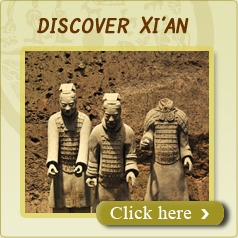Xi'an Tourism

- City Name:Xian (Chinese: 西安, Pinyin:xian)
-
Population :Municipality 8,252,000, Metro: 2,670,000
-
Location :located at 34°16′N 108°56′E / 34.267°N 108.933°E / 34.267; 108.933
-
Overview:Since the 1990s, as part of the economic revival of interior China, the city of Xi'an has re-emerged as an important cultural, industrial and educational center.
Overview
Xi'an is one of the four major tourist cities in China and it is the largest city in in Shanxi Province, its long history can be traced back to more than 3000 years ago. From the earliest societies, people lived and multiplied here. As one of the six ancient capital cities in China, Xian was the capital for the longest time - it served 12 dynasties (more than any other city) for 1,120 years, including the well-known Western Zhou, Qin, Western Han, Sui and Tang, stretching over a total of more than 2000 years.
Xi'an China is also a world-famous tourist city, a treasure house of cultural relics. The remains of past civilizations furnish evidence of every major epoch in China's half a million history, making for a particularly illustrative textbook of Chinese culture.
Know More
Xi'an is the capital of Shaanxi province. And it is one of the four Great Ancient Capital Cities together with Athens, Rome and Cairo. It was the starting point of the Silk Road, where camels were loaded for their long and perilous journey to Central Asia. Xi'an's links to Central Asia goes beyond trade as Islam continues to have an influence on the local flavor through the Muslim Hui minority.
As dynasty after dynasty added their own mark to Xi'an, the relics of old palaces, temples and tombs abound throughout the city and surrounding countryside. The tyrannical Qin dynasty emperor Qin Shihuang, with his capital at Xianyang, close to present day Xi'an, left his indelible mark through the famed Terracotta Warriors. It is a must see attraction about Xi'an travel.
The Tang Dynasty is considered one of China's golden ages for its unmatched cultural achievements. Trade reached Central Asia and Europe, thousands of students from Japan and Korea arrived in Xi'an to study the Tang cultural, and Chinese monks traveled to India to copy Buddhist sutras. At its zenith during the Tang dynasty, Xi'an was the world's largest and more cosmopolitan city, measuring 84.1 square kilometers with over one million residents.
Though Xi'an was large, it was not affected by the incomprehensible twisting and turning lanes of similar cities of the era. As the first planned city in China, it was organized into a neat grid layout, highly symbolic in geomancy. The layout of Xi'an city would influence other cities such as Beijing, etc.
Nowadays, the Xi'an city's charm lies in its historic atmosphere, there's a palpable sense of past glories, vestiges of its history are ever present.
One can easily imagine the sights and sounds of Xi'an at the height of its glory when wandering along the city walls or strolling through the old Muslim quarter. Xi,an travel guide you to discover this ancient city.
Xi'an Travel - Must See
The Terra Cotta Warriors is only a part of the Qin emperor's tomb complex. They may have remained forgotten had it not been for the fortuitous discovery by local peasants drilling a well in 1974. What they found would excite the archeology world...more
It's amazing how Xi'an history envelops you, when biking atop the old City Wall and enjoying a great view of the city. Xi'an's gray City Walls are imposing and built to keep out bandits and barbarians. The massive walls measure 12m high and 16m wide at the base, tapering to 12m to 14m and is 13.74km in circumference...more
A large complex of the old and huge architecture - Great Mosque, which is still an active place of worship. According to the historical records carved in the stone tablets which are still preserved in it, the mosque was set up in 742 AD for Muslim traders from Central Asia who settled jn Xi'an during the Tang Dynasty. So it has already had a history of over 1,250 years....more
The pagoda is regarded by many as the symbol of Xi'an China. It was built to house and protect Buddhist scriptures collected by Chinese monk, Xuan Zang, who spent 17 years traveled to India and back for their collection and an equal mount of time did the translation. His journey has been immortalized in the novel Journey to the West, one of China's most important literary works....more









